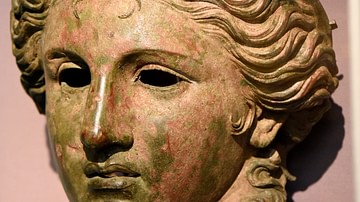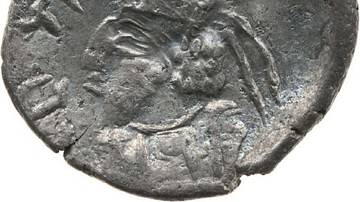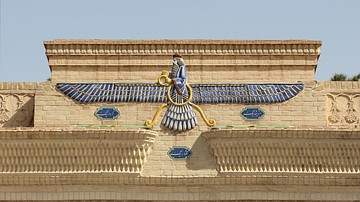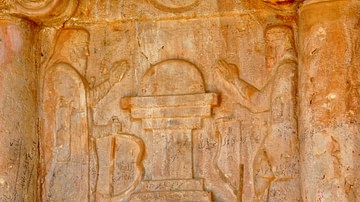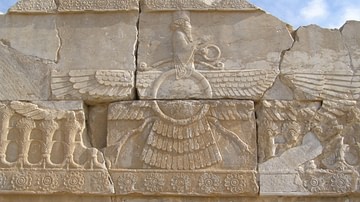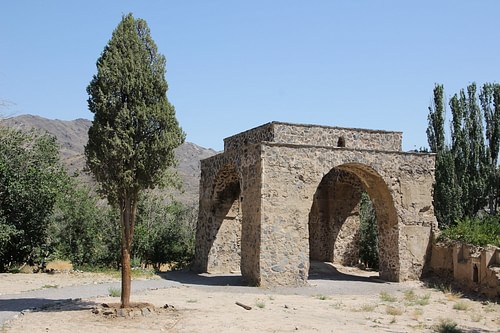
Fire Temples are places of worship in the Zoroastrian religion. They were known as ataskada (“house of fire”) by the Persians but are best known today by their Greek name pyratheia (fire temple). They are thought to have originated from the practice of keeping the hearth fire burning throughout the life of the head of a household.
This tradition then developed into the ever-burning flame kept alive in honor of and symbolizing the divine in a place of worship. Early Iranian Religion venerated a god of fire, Atar, who was the fire itself but transcended earthly fire as a divine entity created by the king of the gods, Ahura Mazda.
After Zoroaster (c. 1500-1000 BCE) established his monotheistic religion, Ahura Mazda became the Supreme Being and Atar – along with many of the other gods of the old religion – emanations (avatars) of the one true god. The fire temples at this time may have changed from outdoor altars to enclosures, possibly during the time of the Achaemenid Empire (c. 550-330 BCE) when they first started to appear in the region. Although the Zoroastrians were referenced by the Greeks as “fire-worshippers”, they did not worship fire itself in these temples but the Divine whose immanence was made manifest through the fire. The vitality, warmth, protection, and transformative nature of fire symbolized these same aspects of the divine force.
Fire temples were firmly established by the time of the Parthian Empire (247 BCE - 224 CE) and reached their height of sophistication in the time of the Sassanian Empire (224-651 CE). After the fall of the Sassanians to the Muslim Arab Invasion of 651 CE, fire temples were destroyed or converted into mosques.
Zoroastrians are said to have kept some of the flames from these temples burning in secret, however, and these were used to light the fires in later temples, notably those of the Parsees of India who preserved the Zoroastrian traditions and established fire temples later in that country. In the present day, these fires continue to burn in temples in Iran, India, and elsewhere around the world where they are kept by Zoroastrian communities.
Early Religion, Zoroastrianism, Zorvanism
The Early Iranian Religion was polytheistic with Ahura Mazda as the king of the gods presiding over a pantheon of many others. Among the most important of these gods were Mithra (god of contracts, the rising sun, cosmic order, and kingship), Anahita (goddess of fertility, health, water, wisdom, and war), Hvar Ksata (god of the full sun), Verethragna (warrior-god/defender of the good), Tishtrya (god of agriculture and rainfall), Haoma (god of the harvest, health, and vitality), and Atar. These gods stood in opposition to the lord of darkness, chaos, and evil, Angra Mainyu (also known as Ahriman) and his legion of demons. Human life was defined by which side one chose to support and this choice would also determine one's destination after death.
This belief was retained by Zoroaster after he established his monotheistic faith with the gods now relegated to the position of emanations from the single god Ahura Mazda. One could still pray to Mithra or Atar or the others but with the understanding that these were representations of a single divine entity, not gods themselves, who helped people in their struggle against the forces of darkness. The whole of life was seen in the context of this struggle, as scholar John R. Hinnells explains:
To the Zoroastrians, there can be no greater sin than to associate good with evil, that is, to suggest that the good world is the creation of the Evil Spirit. [Further,] there can be no greater sin than to associate God with evil. Good and evil are contrary realities, as are darkness and light, or life and death. They are opposing substances, not simply different aspects of the same reality. Evil is not simply the absence of good, it is a real substance and force. Good and evil cannot co-exist; they are mutually destructive and must ultimately derive from two first causes which are themselves mutually antagonistic and irreconcilable. (44)
Even so, Zoroastrianism claims that there is only one all-good, all-powerful god and this presents the problem of the origin of evil: if there is no evil in Ahura Mazda, and Ahura Mazda created the world, where did evil come from? This problem was resolved by the belief system of Zorvanism (probably dating to the late Achaemenid Empire and usually referenced as a heretical Zoroastrian sect) which claimed Zorvan (Infinite Time) was the supreme creator and Ahura Mazda and Angra Mainyu were created beings, twin sons of Time, and so Ahura Mazda had not created evil; Angra Mainyu brought evil to the world through the exercise of his own free will.
This contradicted the central Zoroastrian tenet of free will, however, and the importance of human choice in determining one's fate because Time was now the supreme deity, and this led to the development of a fatalistic approach to life and personal choice. Traditional Zoroastrians rejected this concept and eventually developed the understanding that Angra Mainyu was an emanation of Ahura Mazda like any of the other gods but one which chose to seek his own self-interest instead of serving the greater good, thus bringing evil and darkness into the world. Against this darkness, stood the forces of light symbolized by fire and this fire was kept burning in the temples.
Origin & Development
Fire was always an important element in the ancient Persian religion. It was not only the source of heat and light in the home but instrumental in determining guilt or innocence of the accused in legal matters through the Ordeal by Fire. Fire was considered the physical manifestation of Atar and so the accused might be required to walk through fire or endure hot metal poured onto the chest; if the person died, they were considered guilty while, if they lived, Atar had protected them, thus proving their innocence.
The hearth fire was an integral part of everyone's life, however, and, besides its practical uses, symbolized the presence of the god in one's home just as it did in legal matters. The practice of starting a fire in one's hearth when one set up a home, and keeping it burning throughout the life of the head of the household, is thought to have inspired the religious use of fire which developed into outdoor rituals centered around an altar upon which the fire was kept burning. At these rituals, the elements of fire, air, earth, and water were honored, each represented by a deity, but fire was central.
The Early Iranian Religion was an oral tradition and so was Zoroastrianism – the texts were not written down until the Sassanian Period – and so anything known about the earlier faith comes from references in the Zoroastrian texts. It is therefore impossible to know what form these early rituals took or how the fire temple may have developed. There is no mention of fire temples in the Avesta (Zoroastrian scripture) though there are references to honoring the god through fire. It is thought that the fire temple developed through the hearth fire to the altar fire and then to buildings around a central altar and eternal flame. Information on the fire temple, types of fires, and rituals surrounding the fire all come from later Zoroastrian works such as the Bundahisn.
Form, History, & Ritual
The fire temple was erected at a place considered already sacred to the god. Scholar A. T. Olmstead describes the basic form:
In its general aspect, the fire temple was simply a reproduction in more durable limestone of a typical high fort such as Assyrian reliefs show guarding a Median hill town. It was enclosed in a rectangular sacred precinct whose mud bricks represented the wall of the settlement, as the interior buildings with square stone column bases did the houses of the inhabitants. The mountain height on which the tower stood appeared as a series of three wide low platforms outside which began the narrow steep staircase climbing to the small lone door high up in the face. The lowest story, half the total height, showed neither entrance nor window…In the second story was the door, the wood represented by the black limestone, under a simple molding, which in turn was below a tiny false window…windows had become mere decoration, for the sacred fire burning within had to be protected from sudden drafts and would itself give sufficient light. (64-65)
Olmstead's description is based on the ruins of a fire temple built by Darius I (the Great, r. 522-486 BCE) which is thought to have been modeled on an earlier one built by the founder of the Achaemenid Empire, Cyrus II (the Great, r. c. 550-530 BCE) at his capital of Pasargadae. No ruins of buildings dating to the Achaemenid Empire have been positively identified as Zoroastrian fire temples, however, and it is possible the temple of Darius I honored the gods – or a specific god – of the earlier religion.
The early Achaemenid monarchs have traditionally been regarded as Zoroastrians simply because the religion was so well established by the time of their reigns and their inscriptions seem to support this conclusion. These inscriptions, however, could as easily be interpreted as referencing the early faith as is the case with Darius I's Behistun Inscription which mentions “the other gods” in addition to Ahura Mazda.
Even so, based on later ruins positively identified as fire temples, it does seem likely that Darius I's was an early one and, since he was careful to model his reign on that of Cyrus the Great, he most likely would have extended this practice to recreating Cyrus' fire temple. Accounts of Greek writers date these structures to the Achaemenid Empire as early as Cyrus the Great. In keeping with the tradition inherited from the hearth fire, a flame would be lit when a king came to the throne and extinguished upon his death.
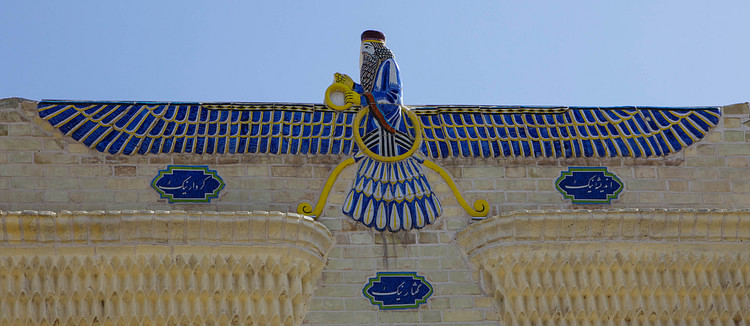
Each king was said to have his own fire, symbolizing not only his reign but the divine grace (farr) bestowed by the gods which enabled that reign. When a king died, the divine grace was withdrawn to be given to another, and so the fire was put out. Once mourning rites were completed for a monarch, a new fire was lighted for his successor.
According to a number of Greek historians (Diodorus Siculus, Herodotus, Pausanias, Strabo, among others), the flame in the fire temple was always burning. It was kept alive on the altar by its hot coals and rekindled five times a day when the priest would enter the temple alone with barsom twigs (symbolizing the earth) which he would place on the hot coals while reciting a prayer and so revive the flame.
The priest would then recite prayers and make offerings to the god. There was no sermon given and no congregation entered with the priest; it was only the priest and his private communion with the Divine. The Greeks saw this ritual as a mystical incantation that kept an ever-burning fire, but the flames on the temples' altars were allowed to burn down to coals – according to these same reports – while there were other fires (known as the Great Fires) which were not.
Types of Fires & Legends
The three Great Fires were:
- Adur Gushnasp (fire of warriors)
- Adur Farnbag (fire of priests)
- Adur Burzen-Mihr (fire of farmers)
All three were said to have come into the world at the beginning of creation and were always kept burning by the priests who tended them. The rivalry of these priests, in attempts to draw the most adherents in pilgrimage to their respective sites, gave rise to a number of legends surrounding them so it is impossible to know how they originated or, for the most part, exactly where. The word Adur means “holy fire” and the second name designates who the fire honored, usually thought to be its founder, although legend claims that all three fires were initially kindled by Ahura Mazda himself and entered the world on the back of the great celestial bull, Srisok, who carried them to where they eventually burned.
Adur Gushnasp was considered the greatest of the Great Fires by the Sassanian monarchs who were themselves of the warrior class and influenced what was written about this subject and every other. Whether Adur Gushnasp was always considered the top-tier of the fires is unknown (and was contested by priests of the time) but it is the only one said to be archaeologically attested to and was kept at Takht-i Soleyman, West Azerbaijan Province, modern-day Iran. Gushnasp means “stallion” and alludes to a myth concerning the fire's founder (a warrior) in which flames attached to his horse's mane and were carried to the site.
Adur Farnbag is thought to have been kept at Pars (modern-day Fars), Iran. Farnbag alludes to glory or good fortune, and this fire was claimed to be the greatest of the three by the priests of the Sassanian Empire. The “glory” referenced in the name would be that attached to the service of God and the “good fortune” would mean the same as regards the founder of the fire. The priests claimed this fire originated in the time of the first mortal king Yima (a mythological figure) and was, therefore, the oldest and should be held in highest honor. As with Adur Gushnasp, legends of miracles and healings were associated with Adur Farnbag just as they were with Adur Burzen-Mihr.
Adur Burzen-Mihr was the fire of farmers – and seems to have been considered the lowest by the priests of the other two sites – but was highly respected by others. Burzen-Mihr translates as “exalted is Mithra” and is thought to be the founder's name but could also allude to the fire in honor of Mithra, god of contracts who was also responsible for fertile fields and fought against the demons of drought and bad harvest. This fire is thought to have been kept in northeastern Iran and was possibly initiated in the Parthian Period but, as noted, legend claims it was much older.
All three fires were of the highest grade of flame that could be produced – a grade known as atash behram (“victorious fire”) – which was produced by 16 other different types of fire taken from various locales including fire from a funeral pyre, from a king's fire, from the hearth of a faithful Zoroastrian, from a shepherd's hearth, a baker's oven, a brewer's shop, etc. These different fires were then combined to create each of the Great Fires. The Great Fires which are kept burning in modern-day fire temples still adhere to this same model and are still kept to stand between the forces of darkness and humanity.
Destruction & Revival
Throughout the latter part of the 7th century CE, the Sassanian Empire fought off incursions by the Muslim Arabs but finally fell to them in 651 CE. Afterwards, Zoroastrianism – along with other aspects of Persian culture – was suppressed. Fire temples were destroyed, along with Zoroastrian texts, or were converted into mosques. This period is most frequently cited by scholars as the reason why it is so difficult to identify the ruins of fire temples in the region – because their destruction was so complete – and those not destroyed or converted by the Muslim Arabs were ruined or completely obliterated by the later Mongol Invasion.
In the 7th and 8th centuries CE, many Zoroastrians fled the area of modern-day Iran for other regions and among these are the Parsees who carried the traditions, and what texts they had saved, to India, specifically Gujarat and, later, Mumbai. They formed a new Zoroastrian community there and revived the religion, preserving it to the present day. After the Muslim Arab persecution of Iranian Zoroastrians relaxed, the religion also revived in Iran where fire temples were rebuilt or new ones created at sacred sites.
In Iran, one of the greatest extant fire temples is the Yazd Atash Behram (founded 1934 CE in Yazda Province) whose fire is said to have been burning continuously since 470 CE. If so, this fire would have been among those kept in secret and carefully moved from place to place during the persecutions by the Muslim Arabs. In Gujarat and Mumbai, fire temples have been standing for centuries, one of the most famous at Udvada, Gujarat, and a number of other significant sites among the 50 temples in Mumbai. They are usually referred to as dar-I Mihr – “the gate of Mithra” and the old god continues to play a part in the rituals of the faith.
In 2017 CE, the Zoroastrians (and others) of Mumbai protested plans for a new underground metro which they feared would damage two Zoroastrian fire temples in the area and diminish the protective power of the fires burning there. This issue remains unresolved three years later as proponents for the metro continue to push for its completion as planned while advocates for the temples propose alternatives, which would avoid damage to the sites or diffusion of the fire's spiritual power. This case, the most recent of its kind over many years, highlights the spiritual and cultural significance fire temples continue to have in the present day as symbols of divine order standing against the forces of chaos.



